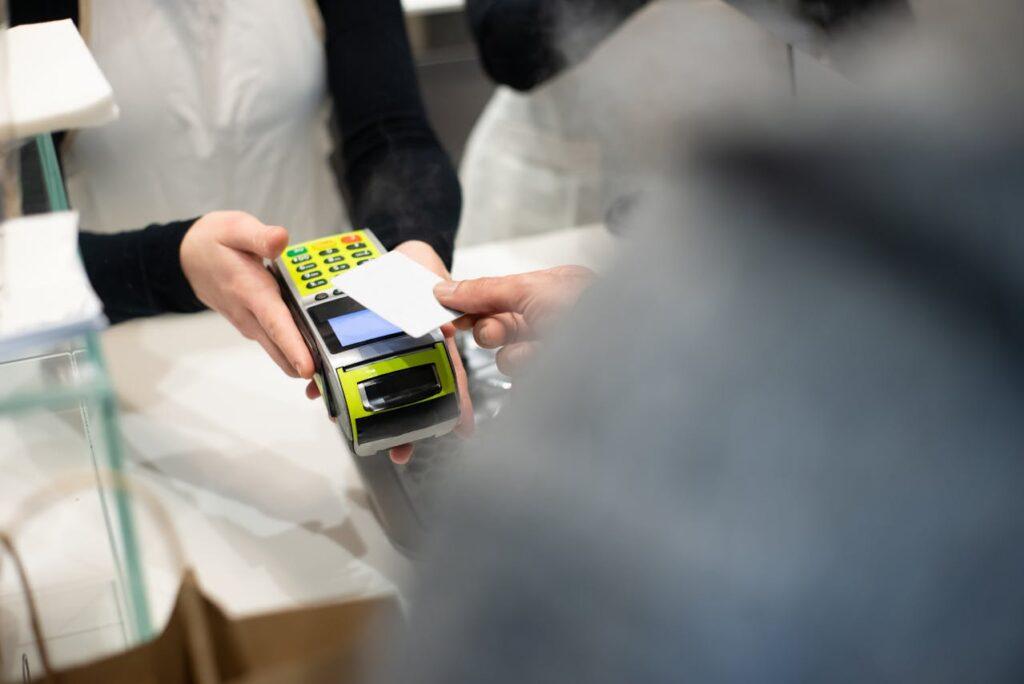How To Determine The Right Digital Payment Option For Your Small Business

Imagine walking into your favorite local café. The aroma of freshly brewed coffee wafts over you, promising a much-needed caffeine hug. You order your usual, reach for your wallet, and … wait, you only have your phone with you. Not to worry, a quick tap on the phone, and voilà, payment made.
Now imagine if that was your café that only accepted cash. Your customer would walk away, craving unfulfilled, and your business would miss out on a sale. This scenario isn’t just a minor inconvenience for customers; it’s a critical business misstep for the business owner.

Whether selling in person or online, offering multiple payment methods, such as credit cards, digital wallets and click-to-pay options, can make it easier for customers to complete their purchases, leading to increased sales and customer satisfaction. By embracing digital payment processing methods, small businesses can cater to their customers’ diverse preferences and stay competitive in an increasingly cashless economy.
“There are three levers you can pull for revenue growth that’s related to the payment world,” said Kelsey Ruger, chief product and technology officer at Hello Alice. “You can sell more, you can increase your price or you can increase the number of sales per customer. If you’re able to take payments in ways that the consumer wants, it’s going to allow you to make more sales, or it’ll allow you to make more sales per customer.”
Expanding Payment Acceptance Options
Offering several ways to accept payments is more than just keeping up with technology. It’s about meeting customers where they are, and people are increasingly looking for convenience in every aspect of their lives, including paying for goods and services.
The landscape of consumer payment options is rapidly shifting towards more mobile-friendly, convenient and secure transaction methods. A recent Mastercard survey showed that 79% of global respondents are now using contactless payments, with those users typically spending more on average than those who use non-contactless methods.
This shift is more than a mere trend; it signals the future direction of commerce. Innovations such as tap-on-phone and click-to-pay are transforming how businesses handle transactions.
Digital Wallets: A Gateway To Seamless Transactions
Digital wallets are proving to be a popular choice among consumers. According to a Forbes survey, 70% of consumers preferred digital wallets for shopping, and 62% preferred them for travel-related transactions.
The adoption of digital wallets is mainly due to their ease of use. Services like PayPal, Apple Pay, Google Pay, Samsung Pay, and Amazon Pay allow for faster in-store and online checkout experiences. They simplify the purchasing process by storing payment information in a secure, accessible manner and offer enhanced security.
By accepting digital wallet payments, businesses can reach a growing demographic that values speed, security and simplicity in their transactions, which could increase customer engagement and loyalty.
Credit Cards: Catalyzing Consumer Spending

The relationship between credit card acceptance and increased consumer spending is well-documented. A Dunn & Bradstreet study found that people spend 12-18% more when using credit cards compared to cash.
This phenomenon can be attributed to the psychological effect of “invisible” money, which tends to reduce the immediate impact of spending, encouraging higher purchases.
Adopting credit card payments is a strategic move for businesses to capitalize on this trend, potentially boosting sales and average order values.
Additionally, credit card conveniences for consumers, including reward programs and the ability to easily make large purchases, further incentivize their use. This makes credit card acceptance an essential feature for businesses aiming to capture more sales and increase their revenue.
Click-To-Pay And Tap-On-Phone: Revolutionizing The Checkout Experience
With 90% of adults owning a smartphone, integrating click-to-pay and tap-on-phone technologies into payment systems appeals to a broad audience and streamlines online and brick-and-mortar stores.
Click-to-Pay simplifies online payments, allowing consumers to securely complete purchases with just a few clicks without repeatedly entering their card details. This method speeds up the checkout process, enhances security, and reduces the risk of data entry errors, significantly improving customer convenience and boosting conversion rates on e-commerce platforms.
Tap-on-phone technology transforms any smartphone into a mobile point-of-sale (POS) system. This technology enables businesses to accept payments directly on their existing smartphones as payment terminals, avoiding the expense and extra equipment. “It’s not only easy for the business but also for their customers,” said Martin Guerrero from Square’s Small Business and Community Advocacy team.
Tap-on-phone is versatile, supporting various operational enhancements such as queue busting and curbside checkouts. It provides a range of fast and secure payment options for consumers, supporting contactless credit and debit cards and mobile wallets. This flexibility, combined with robust security measures, helps decrease fraud rates and enhances the overall transaction experience.
Guerrero shares a memorable experience: “I once assisted a salon owner in setting up tap-to-pay on her employees’ phones. Among her staff was an 85-year-old who was initially hesitant to engage with technology. Now, she happily takes payments using her phone and delights in demonstrating her participation in the digital world, appreciating how it simplifies transactions.”
These innovative payment technologies are tools and transformative elements that adapt to user needs, improve business operations, and usher consumers and merchants into a more efficient digital era.
QR Code Payments: Combining Security with Simplicity
QR code payments represent another facet of the shift towards digital payment solutions, offering a unique blend of security and ease of use. These payments enable customers to pay by simply scanning a QR code with their smartphone, bypassing the need for physical contact or exchanging payment cards.
This method is especially appealing in today’s health-conscious environment, offering a touchless alternative that maintains high transaction security levels. Additionally, QR code payments can be seamlessly integrated into various business models, from retail to restaurants and beyond, providing a versatile and efficient solution to meet diverse customer preferences.
Strategies For Implementing Payment Solutions

Offering various payment solutions is more critical than ever to stay competitive and meet customer expectations. However, navigating the options can be daunting.
Selecting The Right Payment Processors
Choosing a payment processor that aligns with your business model — such as Square for tap-on phone capabilities, Stripe for online transactions, or Shopify for an integrated e-commerce solution — is crucial. Each platform offers unique benefits tailored to different business needs.
Ensuring Seamless Integration
Opt for payment solutions that integrate easily with existing systems, enhancing the operation and the customer transaction experience. Smooth integration and a positive user experience are paramount for customer retention.
Prioritizing Privacy And Security
It’s essential to protect customer data with trusted payment gateways that use robust encryption for both online and in-store transactions. Keeping systems updated and training staff on security best practices reduces the risk of breaches. A strong focus on PCI compliance and fraud prevention builds customer trust and secures your business foundation.
Preventing Fraud And Chargebacks
Protect your business by implementing strong security measures like encryption, address verification, and card verification value (CVV) checks. Use fraud management tools to detect and prevent suspicious activities, safeguarding your financial health.
Educating Your Employees And Customers
Train your employees on new payment methods to ease their job processes and boost sales. Once your team is knowledgeable, they can help educate customers on the benefits of these technologies, ensuring a smooth transition and adoption.
Accepting Local And International Payments
Expand your market by offering various local and international payment methods. Support for international payments and currency conversion can make your e-commerce or SaaS business globally accessible, attracting a wider customer base.
Invoicing And Payment Processing Automation
Streamline invoicing and payment processes through automation. Use email invoicing and small business-oriented software to enhance efficiency, reduce errors, and simplify transactions, making your operations more efficient and reliable.
Navigating Merchant Accounts And Services For Your Business
A merchant account is essential for businesses looking to accept electronic payments, acting as a bank account that processes card transactions. In contrast, payment gateways are the digital intermediaries that authorize and facilitate these transactions.
Some of the key providers include PayPal, Square, Shopify and Adyen and others.
When selecting a merchant account and service, evaluate factors such as transaction fees, accepted payment methods, chargeback policies, and the time it takes to settle transactions.
Payment Gateways And Processors
Payment gateways, such as Stripe and Authorize.net, verify customer card details to ensure the availability of funds, while processors manage the transaction flow between banks.
Compatibility with your existing systems and security protocols is paramount when choosing a payment gateway and processor. Also, consider the diversity of payment options you intend to offer, such as credit cards, ACH transfers or digital wallets, to effectively cater to customer preferences.
Transaction And Processing Fees

Every payment method has specific transaction and processing fees that can affect your bottom line. For example, credit card payments typically have a processing fee that includes an interchange fee, a cost paid to the card-issuing bank.
These fees vary based on the card network and your merchant service provider. It’s important to scrutinize these costs as they can quickly accumulate, especially with high sales volumes.
- Transaction Fees: This may be a percentage of the transaction value plus a fixed amount.
- Processing Fees: These often include smaller fees such as interchange, assessment, and payment gateway fees.
While cash transactions do not incur processing fees, handling and depositing cash can be inconvenient and time-consuming.
Cost-Benefit Analysis For Small Businesses
A thorough analysis helps weigh the costs against the benefits, like reaching a broader customer base or enhancing cash flow, to support your business’s financial well-being:
- Benefits: Might include broader customer base, faster fund availability and increased sales.
- Costs to Consider: Sum of all fees per transaction, setup fees for payment systems and any recurring monthly fees for service providers.
Integrations And Additional Features
When selecting payment solutions for your small business, consider their compatibility with other tools and their extra features. Important integrations include seamless connections with accounting software like QuickBooks, which enables real-time transaction reconciliation.
Additionally, robust mobile and online payment options are essential for online-centric businesses. These should support managing transactions remotely via mobile apps, handling various mobile payment methods, and supporting online appointments.
Adapting your business to include a wide range of payment methods is more than just a convenience—it’s a strategic move that aligns with evolving consumer expectations, boosts revenue and secures transactions. The shift towards varied payment options is backed by data underscoring its necessity for business success.
This article originally appeared on Score.





